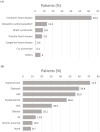Characteristics of patients admitted with heart failure: Insights from the first Malaysian Heart Failure Registry
- PMID: 38131217
- PMCID: PMC10966232
- DOI: 10.1002/ehf2.14608
Characteristics of patients admitted with heart failure: Insights from the first Malaysian Heart Failure Registry
Abstract
Aims: Heart failure (HF) is a growing health problem, yet there are limited data on patients with HF in Malaysia. The Malaysian Heart Failure (MY-HF) Registry aims to gain insights into the epidemiology, aetiology, management, and outcome of Malaysian patients with HF and identify areas for improvement within the national HF services.
Methods and results: The MY-HF Registry is a 3-year prospective, observational study comprising 2717 Malaysian patients admitted for acute HF. We report the description of baseline data at admission and outcomes of index hospitalization of these patients. The mean age was 60.2 ± 13.6 years, 66.8% were male, and 34.3% had de novo HF. Collectively, 55.7% of patients presented with New York Heart Association (NYHA) Class III or IV; ischaemic heart disease was the most frequent aetiology (63.2%). Most admissions (87.3%) occurred via the emergency department, with 13.7% of patients requiring intensive care, and of these, 21.8% needed intubation. The proportion of patients receiving guideline-directed medical therapy increased at discharge (84.2% vs. 93.6%). The median length of stay (LOS) was 5 days, and in-hospital mortality was 2.9%. Predictors of LOS and/or in-hospital mortality were age, NYHA class, estimated glomerular filtration rate, and comorbid anaemia. LOS and in-hospital mortality were similar regardless of ejection fraction.
Conclusions: The MY-HF Registry showed that the HF population in Malaysia is younger, predominantly male, and ischaemic-driven and has good prospects with hospitalization for optimization of treatment. These findings suggest a need to reassess current clinical practice and guide resource allocation to improve patient outcomes.
Keywords: Acute decompensated heart failure; Baseline demographics; Guideline‐directed medical therapy utilization; In‐hospital outcome.
© 2023 The Authors. ESC Heart Failure published by John Wiley & Sons Ltd on behalf of European Society of Cardiology.
Conflict of interest statement
H.A.Z.A. serves as a speaker for AstraZeneca, Boehringer Ingelheim, and Novartis; has received grants from the National Heart Centre Singapore, NHAM, Merck, and Sharp and Dohme; and reports consulting relationship with Boehringer Ingelheim. T.K.O. serves as a speaker for Bayer, Boehringer Ingelheim, and Novartis and reports consulting relationships with AstraZeneca, Boehringer Ingelheim, and Novo Nordisk. W.S.H. is an employee of Novartis Corporation (Malaysia) Sdn Bhd. None of the authors have any direct conflicts of interest related to this article.
Figures

References
-
- Fonarow GC, Heywood JT, Heidenreich PA, Lopatin M, Yancy CW. Temporal trends in clinical characteristics, treatments, and outcomes for heart failure hospitalizations, 2002 to 2004: Findings from Acute Decompensated Heart Failure National Registry (ADHERE). Am Heart J 2007;153:1021‐1028. doi:10.1016/j.ahj.2007.03.012 - DOI - PubMed
Publication types
MeSH terms
Grants and funding
LinkOut - more resources
Full Text Sources
Medical
Research Materials
Miscellaneous

